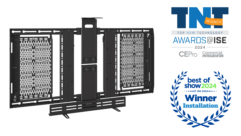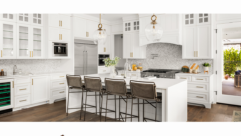Dual-Purpose AV Addresses Intelligibility
The renowned Aspen Music Festival and School, a classical music festival and academy, is a mecca for pros and prodigies alike as the classical world turns its ears toward Aspen, CO, each summer.
CHALLENGE: Design and install a sound system that can address the conflicting requirements of good speech intelligibility and amplified music reinforcement, without destroying natural acoustics for orchestral music.
SOLUTION: Carefully select the optimal audio system components, and implement precise aiming and extensive use of prediction and control software.
The Aspen Music Festival and School features concrete flooring, wooden seating, and a tiered, highly reflective wood stage surrounded by a steel superstructure framed with fabric to form a permanent tent. While beneficial in a concert hall, these features also helped to degrade intelligibility for other events.
The renowned Aspen Music Festival and School, a classical music festival and academy, is a mecca for pros and prodigies alike as the classical world turns its ears toward Aspen, CO, each summer. Both maestros and students have been making the pilgrimage for 57 years not only to perform, but to learn, teach, and witness debates of social issues confronting the world.
Although the students and attendees addressed important challenges, Chicago-based acoustical consulting firm Kirkegaard Associates was faced with solving an immediate dilemma for the festival. In a space known for its poor speech intelligibility, the firm needed to reinforce sound for the spoken word and dramatic segments of the festival without audibly or visibly intruding on the classical music performances.
Although Kirkegaard Associates is recognized for its designs in a variety of well-known venues, the setting in Aspen presented some difficult design obstacles. It has a tiered, highly reflective wood stage surrounded by a steel superstructure framed with fabric to form a permanent tent. The flooring in front of the stage is concrete with wooden seating throughout. While beneficial as design elements in creating the desired reverberance of a concert hall, they’re also responsible for degrading intelligibility when the sound system isn’t properly designed for the conditions.
After the installation of the JBL VT4888 VerTec line array clusters was completed in the Aspen venue, Chicago-based acoustical consulting firm Kirkegaard Associates tuned the system using SIA Software’s SmaartLive system measurement tool.
“We started out discussing with them a way to install a speech system,” says Richard Laidman, senior consultant with Kirkegaard Associates. “The previous system was comprised of distributed point source boxes. With a concert hall reverb time of around 4 seconds unoccupied and 2 seconds occupied, achieving good intelligibility with that system was nearly impossible. We investigated a few different approaches such as steerable line arrays and other, small curvilinear line arrays with limited low frequency range.”
Yet, Aspen’s representatives also mentioned that they might want to support singers that play with Pops-type orchestras and satisfy other vocal criteria.
“That immediately put up a flag for us,” Laidman says. “We knew then that we needed a high-quality system with a level of control that could handle speech well, but that could also address any extra needs for reinforcement, even though the music currently programmed in the tent doesn’t have a big requirement for amplification.”
Adding to the acoustical challenges in the reverberant space and the multiple criteria were aesthetic issues. A major objective for the producers of the Aspen event, or any other classical event, is to add unobtrusive reinforcement.
Chicago-based acoustical consulting firm Kirkegaard Associates used two clusters of six JBL VT4888 VerTec line arrays and two JBL AM4200/64 mid/high enclosures mounted behind the line arrays for side fill. The clusters were rigged with two 1-ton chain hoists for each cluster, with the clusters’ locations aligned so that the hoists can drop through the steel trusses that support the canopy.
Thinking that line arrays would fit the bill, Kirkegaard used JBL’s Line Array Calculator program, which suggests an optimum array while allowing for any adjustments in the number of cabinets and specific rigging requirements. The firm designed and installed the original acoustic space in Aspen, so Kirkegaard took its old drawings and inserted graphics of the new speakers, and then submitted it for the festival owner’s approval.
Because the steel and wood structure that supports the tent rises 30 feet above the seating area, and the seating wraps around in front of the stage, the calculator showed that line arrays would provide excellent direct coverage, but would require some side fill to cover the extreme right and left portions of the seating, as well as front fill to cover the closest rows. Aspen’s existing four JBL Marquis MS26 loudspeakers handled this task well.
After the array calculator provided some direction, Kirkegaard tweaked the design to open the splay angle of the line array cabinets a bit wider. The information from the calculator was transferred into the EASE computer modeling program to determine how the performance modeled over the entire seating area, both horizontally and vertically. Laidman says that the ability to model the JBL VerTec products in EASE, as well as in the JBL Array Calculator greatly simplified the task.
It was in creating the EASE model that Kirkegaard discovered the tiered seats closest to the stage weren’t getting enough coverage above 2 kHz without the use of side fills.
WORKING THE ANGLES
One of the important elements of the Aspen Music Festival installation was the seamless intelligibility achieved in listening to the large JBL VerTec line arrays, and transitioning to the small AE Series used for side fills and Marquis Series for front fill. This raises the question of how JBL achieves consistent voicing across a diverse product line.
It begins with Floyd Toole, vice president of acoustic engineering for Harman Pro Group, JBL’s parent company. Various in-house and external facilities are employed, including the Multichannel Listening Laboratory, which adds precise qualification to measured parameters of the sonic properties of finished products.
Based on this research, products are tested through a series of empirical experiments that ensure a consistent level of performance in everything from on-axis frequency response to total power response. The evaluation process compares the products and technologies in question to engineering reference samples of existing JBL models, as well as samples of the competition.
In the final step, a committee of expert listeners (experienced JBL personnel) listens to the products for final sign-off approval. Nothing moves on to the production stage without the committee’s approval.
Because many JBL systems use common technologies like the company’s Differential Drive dual voice coil engines, sonic characteristics are easier to approximate in different loudspeaker models.
Regardless of the specific speaker components used, they’re all measured in the same way — in both the design phase and at the end of the production line. Both transducer and system designs are qualified in the same manner.
At the end of each production line, each transducer and each complete system is individually measured against the engineering standard unit to guarantee performance consistency. Samples of each transducer production lot are also power tested to further ensure reliability.
“We used zoned monaural, left, and right clusters, although they can be run in stereo,” Laidman says. “We chose two clusters of six JBL VT4888 VerTec line arrays because we had experience with them, appreciated their consistency and focus, and liked the sound. For the side fills, we used two JBL AM4200/64 mid/high enclosures mounted behind the line arrays. Because all the JBL product categories are voiced similarly, they blended very well acoustically, and we barely noticed the transition as we walked around the seating area (see sidebar).”
The VerTec line arrays offer narrow vertical pattern control, complemented by side fills that radiate energy only where they’re focused, and the front fills provide a tight focusing of the energy, resulting in intelligibility and clarity. After completion, the system was tuned using SIA Software’s SmaartLive sound system measurement tool.
“We use Smaart, because it lets us look beyond a lot of room issues when using its transfer function mode”, he says. We use it on a regular basis because it’s fast to set up, and provides a good assessment of the loudspeakers’ performance so we can get accurate adjustment of the measured EQ curve.” Laidman adds that adjusting the measured curve is the start of good EQ, but that the subtle adjustments using the human ear complete the job.
Signal processing required some additions to the existing BSS Audio Soundweb Green system. Because all of its outputs were used, a Soundweb 9088 was added, along with a dbx DriveRack 4800 for direct control of the signal processing.
Powering the speakers was another issue. The existing rack room was out of space and the distance to the clusters would require very large wire and conduit.
To address this, the design called for JBL VT4888DPs self-powered loudspeakers, which include integral Crown amplifiers that attach to the back of the cabinets. The speakers are adjustable, and can be monitored using Harman Pro Group’s HiQnet networking protocol via the DPAN cards in the Crown amps.
The design of the HiQnet system, the power and audio cabling requirements, and the rigging were on a tight schedule with the festival to open in less than two weeks.
“It helped that they had existing DSP, and the routing and DSP that we added to it was smooth because the HiQnet system talked to everything,” says Albert Lechesse, president of Audio Analysts, the Colorado Springs-based sound company that handled rigging and the implementation of the HiQnet system. “Also it makes for an electronic system that was easy to adjust.”
FOR MORE INFORMATION
BSS Audiowww.bss.co.uk
Crownwww.crownaudio.com
JBL Professionalwww.jblpro.com
Renkus-Heinzwww.renkus-heinz.com
SIA Softwarewww.siasoft.com
The clusters were rigged with two 1-ton chain hoists for each cluster for a total of four, with the clusters’ locations aligned so that the hoists can drop through the steel trusses that support the canopy. All of the cable runs were directed there as well.
Because the electrician had already run power lines for lighting, the installers only had to run powered multi-cable, six-circuit multi-cord for the amplifiers. “We just had to install a conduit for the audio,” Lechesse says.
Six 20 amp circuits were allotted for both stage left and right. Audio Analysts also ran Cat5 cable for control, and added an Ethernet switch on the grid so they didn’t have to run lines to each speaker. In all, the cabling comprised one power multi-pin, one Cat5, and one audio cable.
Tim Wetmore is a freelance writer based in New York City. He can be reached at [email protected].










